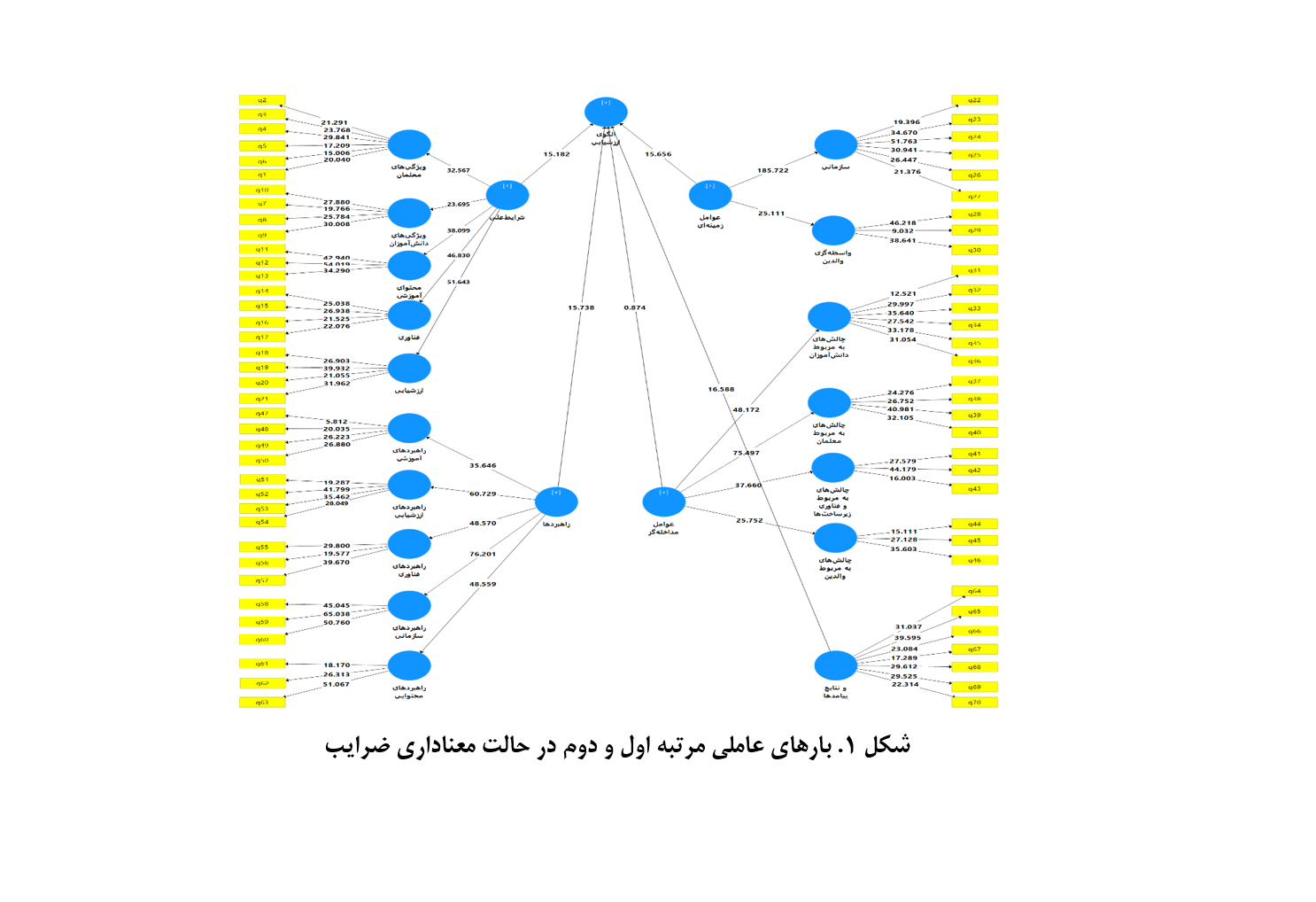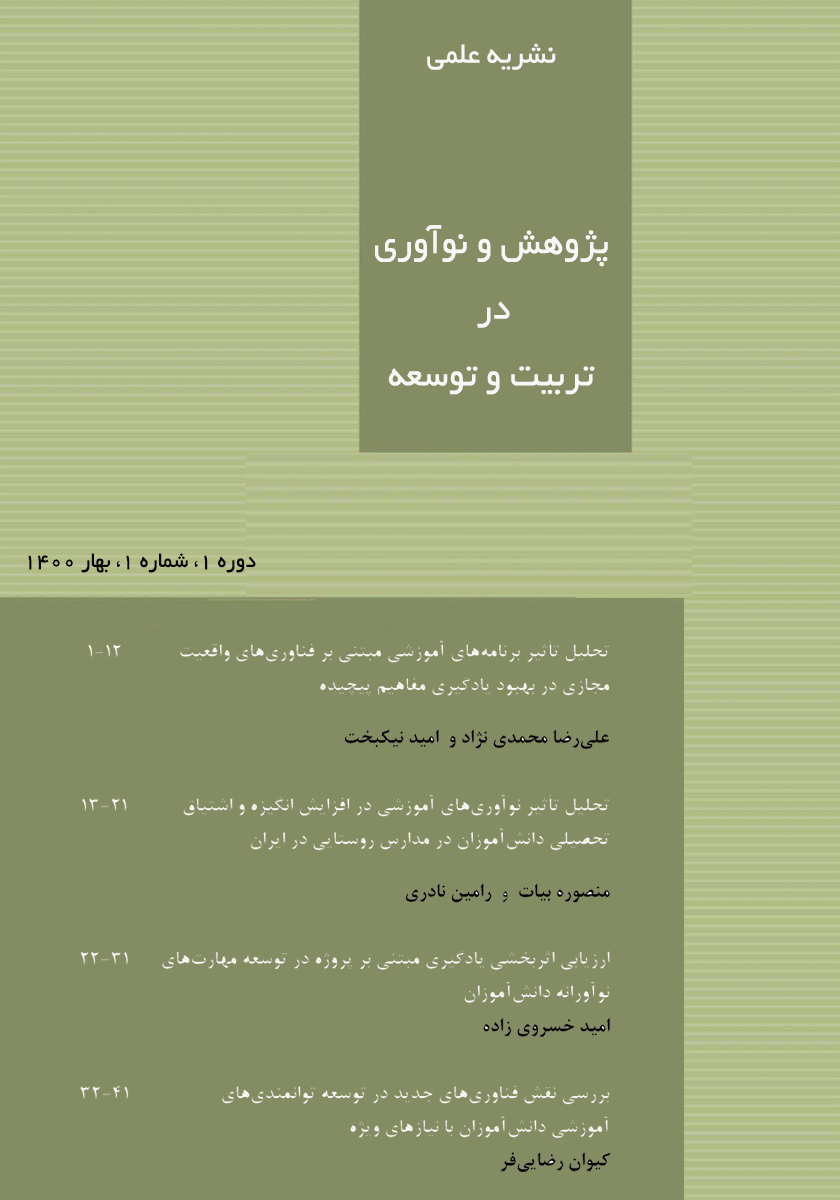Validation and Prioritization of the Dimensions and Components of the Academic Progress Assessment Model for Primary School Students in E-Learning Programs (Shad)
Keywords:
academic progress assessment model, virtual education, prioritization of dimensions, progress components, Shad networkAbstract
The present study aimed to validate and prioritize the dimensions and components of the academic progress assessment model for primary school students in e-learning programs (Shad) using a mixed-methods approach (qualitative-quantitative). The study was applied in terms of its objective and descriptive-survey in terms of its type. The statistical population consisted of university professors, school principals, experts, and primary school teachers. A purposive sampling method was used to select 25 participants for the qualitative phase, with the sample size determined based on the theoretical saturation of the data. A random cluster sampling technique was employed for the quantitative phase, with 240 participants selected. The data collection tools for the qualitative phase included semi-structured interviews, and for the quantitative phase, a researcher-made questionnaire was used. The qualitative data were analyzed through a three-stage coding process, and the quantitative data were analyzed using descriptive and inferential statistics. After analyzing the data, five main categories, 18 subcategories, and 70 key indicators of the model’s essential components were identified. To prioritize the dimensions and components of the model, the Friedman test was used, while construct validity, composite reliability (CR), Cronbach's alpha coefficient, and the Standardized Root Mean Square Residual (SRMR) index were employed to evaluate and fit the model. Given that the SRMR index was less than 0.08, it can be concluded that the model fits well. The results of the quantitative phase confirmed the findings from the qualitative phase.
Downloads
References
Abbasi Kasani H, Shams Moorkani G, Seraji F, Rezai Zadeh M. Tools for Evaluating Learners in E-Learning
Environments. Technology Growth Quarterly. 2019;27(31):39-50.
Jaakkola T, Veermans K. Exploring the effects of concreteness fading across grades in elementary school science
education. Instructional Science. 2017:1-23. doi: 10.1007/s11251-017-9428-y.
Gitomer DH. Measurement issues and Assessment for Teaching Quality. Los: [Publisher Missing]; 2009.
Neuman L. Basics of Social Research: Qualitative and Quantitative Approaches: Allyn & Bacon; 2007.
Pavri S. Effective Assessment of Students; Determining Responsiveness to Instruction. Upper Saddle River, New
Jersey: Pearson Education, Inc.; 2012.
Sindelar NW. Assessment-powered teaching: Corwin, a Sage Company; 2011.
Luka I. Summative evaluation of online language learning course efficiency for students studying tourism and
hospitality management. Quality Assurance in Education. 2018;26(4):446-65. doi: 10.1108/QAE-04-2018-0051.
Garrison DR, Anderson T. E-Learning in the 21st Century. Zarai Z, Safaie M, editors. Tehran: Science and Technology
Publishing; 2005.
Garrison DR, Anderson T. E-Learning in the 21st Century. British Journal of Education Technology. 2012;38(4):755.
Zarai M, Zarai Zowarki E, Aliabadi K, Dalavar A. Design and Validation of a Social Network Model for Schools in
Iran. Journal of Educational Technology. 2019;13(2).
Zarai Zowarki E. Theoretical and Scientific Foundations of Internet Applications in Teaching and Learning Processes.
Tehran: Avaye Noor; 2013.
Terbati Nejad H, Kaviar A, Ghandizadeh M. Predicting Academic Achievement Based on Achievement Motivation
and Self-Regulated Learning Strategies in High School Girls. Quest in Educational Sciences and Counseling. 2022;8(16):24-
Beigi N, Rezazadeh Bahadoran H, Khosravi Babadi A-A, Pooshneh K. Design and Field Validation of an
Implementation Model for Academic Progress Evaluation in Elementary Schools. Curriculum Studies. 2021;16(62):83-110.
Bit Siyah F. Investigating Factors Affecting Academic Achievement in Secondary Education. Journal of
Psychological and Educational Sciences Studies. 2021(7):280-9.
Hojati SA, Yarahmadian MH, Kashti-Aray M. Designing a Suitable Academic Progress Evaluation Model for
Technical and Engineering Fields Based on the Lived Experiences of Professors and Students. 2017;8(2):321-38.
Yang C. Exploring the Possibilities of Online Learning Experiences2020.
Azizi N, Heidari S. Elementary Teachers' Attitudes Towards Descriptive Evaluation in Sanandaj City. Educational
Sciences (Educational and Psychological Sciences). 2012;6(2):0-.

Downloads
Published
Submitted
Revised
Accepted
Issue
Section
License
Copyright (c) 2025 Journal of Study and Innovation in Education and Development

This work is licensed under a Creative Commons Attribution-NonCommercial 4.0 International License.










